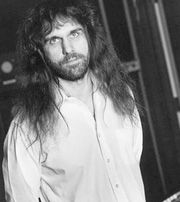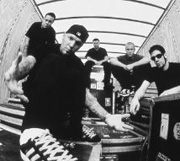CLASSICAL SOUNDS have traditionally never gone over well with longhairs whose prime aptitudes include belching the national anthem and dodging employment like Robert Downey Jr. does urine tests. But that’s all been changed at the 120-plus hands of the Trans-Siberian Orchestra, a metal-minded assemblage that blends Beethoven with Budweiser—which, as it turns out, is the best innovation for metal aficionados since the advent of pizza delivery.
Trans-Siberian Orchestra
Paramount Theater, Wednesday, December 13
Neurological evidence shows that listening to classical music can raise your IQ. Moreover, since classical music stimulates both sides of the brain, listening to it primes one’s mind to be both intuitive and logical. Classical music can coordinate right-brain imagery with left-brain deduction to help the metalhead generate imagery to remove mental blocks, expand perceptual horizons, and solve problems more easily. Now the thrashers can fill their heads with creative thought at the same time they’re banging them. The ramifications promise to be profound: Headbanger punch lines (Q: What did the Ozzy fan get on his SATs? A: Drool) will no longer be valid. Metal fans will don spectacles instead of being one. Job applications, instead of midsections, will get filled out. Anheuser-Busch stock will plummet. Or most likely, some loud-ass Christmas jams will get kicked out.
Adding to the novelty of melding metal with full-fledged classical orchestration is that the Trans-Siberian Orchestra have done it all within the context of Christmas. Formed by Paul O’Neill, not the Yankee slugger but producer/songwriter for Florida-based metal band Savatage, TSO began as a way for him to expand upon Savatage’s sprawling rock operas while creating music he deemed more uplifting than the dark themes that the band’s music often revolved around. Thus, O’Neill spiked traditional Christmas carols with metallic flourishes to birth true symphonic metal that’s enough to get Kriss Kringle’s Bic in the air.
Debuting with Christmas Eve and Other Stories in 1996, the band scored an immediate hit with “Christmas Eve/Sarajevo 12/24,” which is now as much a fixture on classic-rock radio come the holidays as creepy old guys in Catherine Zeta-Jones’ bed. Embellishing “O Come All Ye Faithful” with solos that would pitch a tent in Yngwie Malmsteen’s pantaloons and turning the “Russian Dance” into a sub-Metallica elf stomper, the album is as guilty a seasonal pleasure as whizzing on the neighbor kids’ snowman.
Complete with tremulous operatic male vocals, Rudolph-exenterating power chords from Megadeth axman Al Pitrelli, and an elaborate storyline about an angel descending to Earth, TSO’s debut—played by a 60-piece orchestra—is as portly as waistlines after the December deluge of dense fruitcakes. And in that way, it is a fitting Noel for the Clinton era of abundance; it is every bit as excessive as the holiday that it celebrates.
The record also managed to go gold and became one of the most successful Christmas albums of the year, outselling holiday releases by Garth Brooks, Mariah Carey, and Barbra Streisand. The band’s second album, The Christmas Attic, was equally well received and established TSO as a seasonal sensation.
EARLIER THIS YEAR, TSO released their first non-Christmas record in the form of Beethoven’s Last Night, a concept album that recounts the events on the eve of Beethoven’s death. And while it isn’t a yuletide record per se, it is still steeped in the spirit of Christmas, bringing together the seemingly disparate bodies of classical and metal and urging them to put aside their differences.
And it’s about time these two finally hopped in the sack together; after all, the genres have more in common than most married couples (particularly those involving a hot Welsh actress and a moldering Hollywood codger). Perhaps the greatest shared trait between the two musics is a love of pomp, as both are enraptured with grandeur and pretense. From its sweeping arrangements and haughty demeanor, classical music eschews austerity like Republicans do recounts. Metal, on the other hand, is just as extravagant. What other form of music has, in the past, boasted live performances featuring 18-foot dragons, steel knights battling with laser swords, and stages filled with explosions? From the epic vainglory of classical’s inflated intellect to the tumescent Tolkien tendencies of metal, the two genres are cousins in conceit, with the only real differences being hair length and keg stand prowess.
Yet for years the classical snob and the metal slob have been at odds, having as much difficulty seeing eye to eye as Manute Bol and Emmanuel Lewis. Thanks to the concerto crunch of TSO, however, this gap has been bridged. And the union is sure to be a symbiotic one. Classical aficionados can show metal fans how to select the proper Brie; metalheads, in turn, can school the former on cutting it, in addition to other creative ways of expressing one’s bodily functions. It’ll be a gas.






